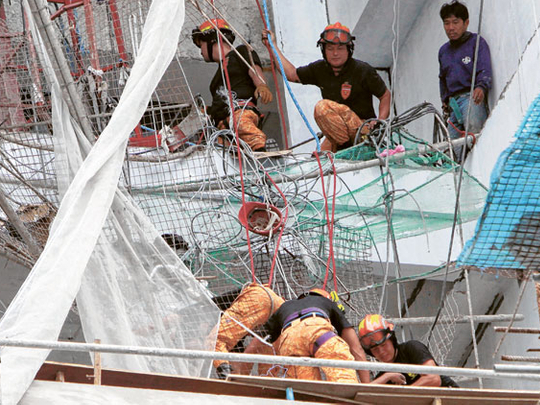People who work to uncover the root causes of an incident or non-quantity outcomes of processes, often feel handicapped by the widely used phrase “blame the process, not the people”.
This article will take a deeper dive into the meaning behind the phrase. The phrase has two nouns “process” and “people”. On the surface the phrase appears to be saying that people never cause incidents or outcome problems. This is not what is meant. A person on a construction site might act in a blatantly unsafe way or make a nonsensical decision leading to injury.
An example comes from a construction site in Makati when 11 workers squeezed into a gondola elevator, which are commonly seen on the side of buildings under construction, in 2011. This was both an unsafe thing to do and nonsensical decision. Ten people died as a result of the gondola crash plummeting from the 32nd to the 7th floor.

Rescuers help a victim from the 7th floor of a building under construction yesterday in Manila. Authorities are investigating the reasons that led to the elevator being overloaded. Image Credit: AP Manila:
The report of the Accident
An overloaded lift could have been the likely cause of the noontime tragedy that cost the life of ten workers yesterday.
A temporary elevator at a building construction site in the Philippines’ capital plunged 25 floors yesterday, killing 10 workers, officials said.
Reports said that the service elevator or “gondola” used by the workers can only accommodate five to six workers, but for still unknown reasons, the lift was carrying 11 workers when disaster struck.
The gondola was taking workers to the 32nd floor of the 40-storey Eton Towers in suburban Makati City’s Central Business District when one of the cables — balancing the elevator on an even keel — collapsed.
The collapsed structure caused the elevator to crash from the 32nd level to the 7th floor.
The workers were installing glass panelling on the façade of the Eton Towers when the mishap occurred just past 12pm, according to the authorities.
According to Eton spokesperson Erwin de Pedro, authorities are trying to look into possible lapses that led to the overloading of the elevator.
De Pedro, in a statement, said workers had taken the gondola instead of the stairs when going down the still under construction Eton Tower.
This caused the service elevator to be overloaded.
The crash had caused immediate death from traumatic injuries to three workers while some of the fatalities expired while undergoing emergency treatment.
Blaming Process
In investigating an incident or an outcome of a process which is not desired, the purpose is to find what might be changed so that it never happens again.
This is where processes come in.
A cable broke – what was the cause of that?
Was it too small for the gondola? Was it attached correctly?
11 people thought it OK to fit into a gondola designed for 5-6 people. Did they know this? What safety instructions were they given? Did the space in the gondola suggest that 11 people can fit easily?
Findings
Further findings were made. An underage person was hired and among those dead. The gondolas were erected without a permit. The gondolas had no maintenance records. All these also affect processes. The findings also showed that only 2 people were allowed on the gondola at one time, according to the investigators. Not the 5-6 originally reported in papers and either fabricated by the reporter or provided by someone on site. If the latter does this mean that the restrictions in weight (650kg) was not known by the users?
Please note I do not know the full outcome of the investigation but you can see the wisdom in not just blaming the people.
In fact, the only time you can blame the person is if they deliberately did not follow the process. BUT, even then the question is why would they do that? Pressure to get a job done? Common practice by others? Non availability of equipment, safety or other?
Learning
- The purpose of looking at the process and not the people is to see what can be changed so that the outcome or incident never happens again. Blaming the person stops that dead in its tracks.
- Processes are everywhere and all work is a process. A process is inanimate and so, if changed and followed, results will also change.
- Sometimes processes are found to be missing in action. In other words, there is no standard process and one needs to be designed.
- Multiple processes can be at play at anyone time. If safety harnesses are not available, for example, it might be the process of ordering or supplying or having correct stock levels – why? why? why?
- Permits – were they not applied for because they take too long and work must go on? Did they not know they were needed? Why? why? why?
Non life-threatening outcomes
I have used a safety example. Undesirable outcomes, though, are, often, linked to administrative, decision-making and operating processes. Supplier payment, approvals, purchasing, performance reviews, budgeting, hiring, reporting of all sorts, IT services, IT software and so on are all processes and the results are as a result of processes and NOT people.
If you do not like the outcomes – change the processes.

